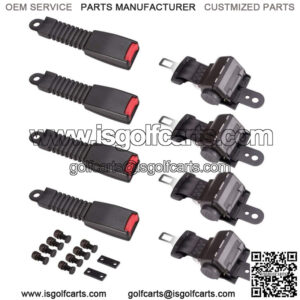HOW TO INSTALL SEAT BELTS ON A GOLF CART
STEP ONE—GATHER UP YOUR TOOLS
First of all, you’re going to need an electrical drill with a strong and fully charged battery or a long power cord attached to a proper extension cord.
You want a drill you can easily handle and one that can drill through metal and other types of strong materials to ensure it operates properly.
Next, you’re going to need a good drill bit set that is adaptable and includes many different multi-sized bits you can use for your drilling.
The sizes will vary depending on the type of kit you own. In the steps below, we’ll go into more depth on which are the best ranges of sizes for you.
Make sure you also have a 3/8 drive ratchet or a size that is similar to that and various wrenches that are appropriate for this process.
Lastly, it is also important to gather up safety gear to protect yourself and others while you work on your cart.
You should park your cart in a contained area, like a garage, and on top of a large sheet to catch any items you may drop.
Then, you need to make sure you put your cart in Park as you work, turn off the ignition, and put blocks behind the wheels.
You’re also going to need a good pair of gloves and some safety goggles as you work to protect you from any potential issues.
These items help keep you from developing any blisters on your hands as you work and also prevent eye damage that may be quite painful.
STEP TWO—LINING UP YOUR SEAT BELT BRACKET
The next step in this process is lining up your seat belt bracket in such a way that it is supported by the frame of the cart and strong.
Typically, you’re going to have to move your seat back support up a little bit so you can have easier access to it as you work.
Look at the edges of your seat back support.
Are there any bolts holding it down to the frame that need to be removed?
Use your wrenches to take these bolts out, carefully sizing up these bolts as you do to ensure you can properly remove them without any serious issue.
If you find that there are no bolts on the seat back, you are in luck because that means you can just pull the seat forward without doing any extra work.
After you have pulled the back forward, you can place the seat belt bracket—which should have been included with your kit—on the frame and adjust it so that the short end is facing forward.
You want to make sure the short seat belt bracket is in front of the seat belt support and adjust the positioning of the bracket until this is the case.
You may need another person to help you with this process because they can hold the bracket in place as you drill out the holes.
In some cases, you may even need a third person to hold the bracket on the frame, though the bracket may sit comfortable on the cart if it is designed for it.
STEP THREE—ATTACHING THE BRACKET
Once your bracket is properly in position, you can use a series of different bolts, washers, and nuts to hold the bracket down.
We suggest you use four M10X60 bolts at the proper bracket holes—these should be very obvious on the frame—along with eight M10 washers and four M10 nuts on your frame.
Your bracket is likely to come with these attachment items, though some models may not have them if you buy a bracket on the used market.
Start out by drilling holes into the four attachment spots on the bracket using your electric drill and the appropriately sized bit.
Check the bit description to see if it is suitable for your M10X60 bolts.
You should be able to find the right bit in the metric sizes.
After the holes are properly drilled out on your cart’s frame, you can place a M10 washer on the end of each bolt, screw the nut into place, and then add a secondary washer beneath it.
This extra step helps to make sure you can easily loosen or adjust your bolts via the nuts, while the washers protect the nut and the frame from damage.
Tighten each of these bolts into place one at a time, and tighten them fully in a clockwise motion.
By this, we mean put each bolt into place and slowly tighten them evenly to hold the bracket in place.
This staggered tightening process ensures that you don’t put too much strain on the frame of your cart or the bracket, protecting it from serious damage.
At this point, your bracket should be firmly in place and strong on your cart’s body, protecting it from shifting or sliding while you drive your cart.
STEP FOUR—ATTACH THE SEAT BELTS
With your bracket fully attached and in place on your cart, you can now start to attach your seat belt to the cart using the properly supplied tools.
You’re going to need two 7/16 flange bolts, four 7/16 washers, and two 7/16 nuts.
Again, these items should be included in separate plastic bags with a new seat belt bracket kit.
Now, you need to find each bracket end–which should be easy to spot on the bracket because they’ll be the only place you can attach your seat belts–and slide the belt and the rest of its mechanics onto them.
Once you have these belts in place—making sure you eyeball their balance between the vertical and the horizontal sections to keep them in place—you should use your bolts, washers, and nuts the way that we discussed in the previous section.
Make sure you tighten them up using the same even method.
Doing so helps to keep them from getting too tight on your brackets.
At this point, you have everything in place but your lock buckles, which you will add on the mounting plates of your cart using the steps outlined below.
After you have fully installed your lock buckles, you’re going to do a brief test of your cart’s seat belts to ensure they are comfortable and feel safe for you when you drive your cart.
STEP FIVE—ADDING YOUR LOCK BUCKLES
Check your cart seat belt brackets and find the inner mounting plates at the bottom of the bracket.
You should notice a hole where you will screw in your bolts.
These should be pretty obviously where you are going to place your lock buckles, as they are going to be towards the bottom of your bracket’s body and where you’d imagine placing the buckles.
You’ll use two 7/16 bolts, four 7/16 washers, and two 7/16 nuts to attach your lock buckles into place on your golf cart’s bracket.
Attach the locks to your bracket using the methods outlined above.
Your cart’s seat belts are now installed.
After you have your lock buckles in place, you need to make sure you test them to ensure they don’t have any issues.
Get in your cart and put on your belt, removing the blocks before you start, and put the key in the ignition and the cart into forward.
Start up your cart and drive it as fast as you can, stopping as sharply as your brakes allow you to once you’ve reached a good top speed.

